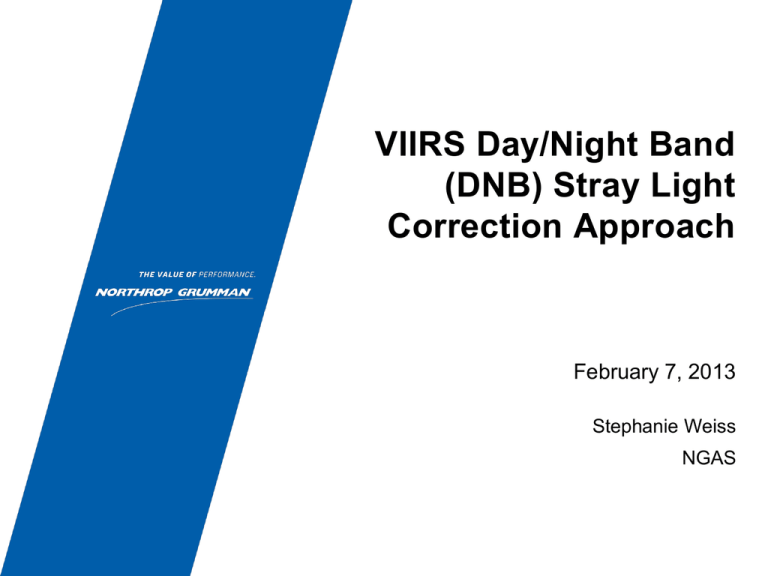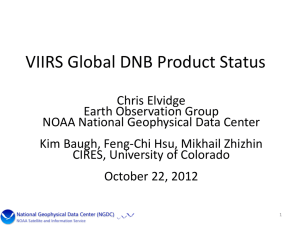VIIRS_DNB_StrayLight_Correction_NGAS_02072013
advertisement

VIIRS Day/Night Band (DNB) Stray Light Correction Approach February 7, 2013 Stephanie Weiss NGAS Outline • Overview of DNB Stray Light • Stray Light Estimation and Correction Approach • Examples of Corrections and Seasonal Dependence • Stray Light Correction Implementation Options • Summary DNB Stray Light Summary Description • Stray light appears on the night side of the terminator – Occurs for both the northern & southern terminator crossing – Affects different segments of the orbit in the northern and southern hemispheres – Stray light has detector dependence, striping is apparent – Level of stray light changes with scan angle, but extends across the entire scan Track Scan Sudden change in radiance parallel to scan due to stray light Copenhagen London 3 d20120915_t0126328_e0129224 S. Weiss, NGAS Cause of Stray Light in DNB • Analysis of the Earth View (EV) and calibration view data indicate that the stray light is caused by direct contamination from sunlight – Stray light does not fall off as the scan travels away from the sun, ruling out that the source of scattered light is entering in from the telescope aperture – The stray light ends when the sun is eclipsed by the earth relative to the spacecraft, which indicates that the stray light is caused by a direct path from the sun • These are the assumed stray light paths: – Stray light from sun shining into EV port only (northern & southern hemisphere) – Stray light from sun shining into EV port during penumbra (northern & southern hemisphere) – Stray light from sun shining into EV port and solar diffuser (SD) (southern hemisphere only) 4 Characterization of Stray Light • Stray light was characterized by analyzing the DNB radiances in the affected region using very dark scenes – New moon data over ocean, with little or no artificial lights • It was determined that the stray light has the following dependencies: – Scan angle (or frame number in scan direction) – Solar zenith angle relative to the spacecraft (S/C) – Solar azimuth relative to the spacecraft, changes seasonally – Detector number 5 DNB Radiance showing stray light on night side of terminator -9 Radiance, day:20120618; time:110359 to 110938 x 10 5 -9 Radiance, day:20120618; time:110359 to 110938 x 10 5 1000 4.5 Stray light changes as a function of S/C Solar Zenith 4.5 1500 1000 4 4 3.5 2000 3.5 2000 3 3 Detail 2500 2.5 3000 2.5 2 2 3000 4000 1.5 Striping indicates detector dependence 1.5 3500 Stray light varies across scan Track 0.5 4000 0.5 6000 1000 500 Scan 6 1 1 5000 1000 1500 2000 2500 3000 3500 4000 0 1200 1400 1600 1800 2000 2200 2400 2600 2800 3000 0 penumbra S. Mills, NGAS DNB Stray Light Correction Approach • A stray light correction technique has been developed at Northrop Grumman for estimating and removing DNB stray light • The correction is look-up table (LUT) based, and has dependencies on the spacecraft (S/C) solar zenith angle, detector, frame, half-angle mirror (HAM) side, and hemisphere • The correction is applied to the DNB radiances – Applied only to pixels within the stray light S/C Solar Zenith angle range • Currently, the stray light correction is applied to select images as an offline post-processing step • The plan is to update the operational code to use a DNB stray light correction LUT to remove the stray light from affected scans 7 DNB Stray Light Correction LUT Generation • The stray light correction LUT generation tool is fairly mature – The correction LUT is generated with prototype Matlab code – Requires a trained operator to set fiducial regions and fit parameters for the LUT generation – Input data must be carefully selected to include new moon DNB scenes that have minimal contamination from to auroras and night time light sources • The quality of the stray light correction is based on visual inspection 8 References on Stray Light Correction Development • Details on the development DNB stray light correction approach have been presented at the SDR Weekly Tag-up meetings – DNB_Stray_Light_Mills_NGC_03_08_12.pptx – VIIRS_DNB_stray_light_correction_Mills_NG_06-26-12.pptx – VIIRS_DNB_stray_light_correction_Mills_NG_07-19-12.pptx – VIIRS_DNB_stray_light_ seasonal_change_Mills_NG_08-21-12.pptx 9 Methodology for Correction LUT Generation – Use radiance from terminator crossing close to the new moon, over ocean preferred – Separate scan into 127 bins of 32 pixels each – Eliminate areas where there is significant solar twilight • Pixels with ground solar zenith angles < 105 are excluded from the fits – Remove city lights from fits using night time stable lights database – For each bin per scan, take the medians of pixels within bin for each detector – Adjust for nightglow based on darkest parts of the granule where there is no stray light – Compute cosine of S/C solar zenith angle, which is approximately proportional to amount of solar radiance entering earth view port – Perform quadratic fit of binned data by cosine of S/C solar zenith angle – Fits are performed per bin, per detector, per HAM side for each hemisphere – In twilight regions extrapolate the stray light estimate taken from the non-twilight regions – Data in 127 bins are interpolated to the full 4064 in-scan pixels – 4th order polynomial fit through penumbra (satellite is partially obscured by earth) 10 Northern Hemisphere Characterization Quadratic fit for bin 1, all detectors shown -9 5 Correction in twilight region extrapolated day:20120618; times:110359 to 110938; bin:1 x 10 Penumbra 4.5 Fitting performed on this data Radiance (W cm -2 str-1)) 4 3.5 3 2.5 2 extrapolated 1.5 1 0.5 0 Fitted stray light estimate shown dotted 0.05 0.1 0.15 0.2 0.25 0.3 0.35 -Cosine of SC Solar Zenith Angle 0.4 0.45 S. Mills, NGAS 11 0.5 Northern Hemisphere Characterization Corrected radiance, bin 1, all detectors -8 1 day:20120618; times:110359 to 110938; bin:1 x 10 0.9 Radiance (W cm -2 str-1)) 0.8 Exponential decay is characteristic of twilight radiance 0.7 Corrected radiances shown dotted 0.6 0.5 0.4 0.3 0.2 0.1 0 0.05 0.1 0.15 0.2 0.25 0.3 0.35 -Cosine of SC Solar Zenith Angle 0.4 0.45 0.5 Correction appears to be very good in extrapolated region 12 S. Mills, NGAS Southern Hemisphere Characterization – Stray light for bin 24, all detectors shown Solar diffuser & EV port stray light (2nd order fit) EV port only (2nd order) Residual after correction Penumbra This transition shifts seasonally due to the change in S/C solar azimuth 13 S. Mills, NGAS Penumbra Stray Light EV Port only Uncorrected DNB Image from Sept 15, 2012 – Northern Hemisphere, Northwestern Europe Track Copenhagen 14 London Scan d20120915_t0126328_e0129224 S. Weiss, NGAS Penumbra Stray Light EV Port only Corrected DNB Image from Sept 15, 2012 – Northern Hemisphere, Northwestern Europe Track Copenhagen 15 London Scan d20120915_t0126328_e0129224 S. Weiss, NGAS Uncorrected DNB Image from Sept 15, 2012 – Southern Hemisphere Stray Light from EV and SD Port Track Stray Light from EV Port only Penumbra Scan 16 d20120915_t1856225_e1902011 S. Weiss, NGAS Corrected DNB Image from Sept 15, 2012 – Southern Hemisphere Stray Light from EV and SD Port 17 Track Stray Light from EV Port only Penumbra Scan Fit artifact may be reduced by fine tuning of LUT generation tool d20120915_t1856225_e1902011 S. Weiss, NGAS DNB Stray Light Correction Has Seasonal Dependencies • The DNB stray light is dependent on the solar geometry relative to the spacecraft • The strong S/C solar zenith angle dependency is captured by the DNB stray light correction LUT – The S/C solar zenith angle is used to determine which scans are affected with stray light – The amount of correction is dependent on the S/C solar zenith, detector, frame and HAM side • The seasonal dependency due to the change in S/C solar azimuth angle is not built into the table, but is handled by periodically updating the correction LUT – The S/C solar azimuth angles shift seasonally thus impacting the amount of stray light – In the southern hemisphere, the contamination from the Solar Diffuser Port shifts from month to month – Correction LUTs can be generated as frequently as once per month using new moon data – The correction should be performed with a LUT generated using data that is closest in time for best results 18 Uncorrected DNB Radiances from Sept 15, 2012 (Northern Hemisphere) d20120915_t0307330_e0311480 19 DNB Radiances washed out due to stray light Plot on log10 scale Corrected DNB Radiances using Aug 2012 LUT for September 2012 new moon data d20120915_t0307330_e0311480 Plot on log10 scale Residual striping artifacts in penumbra region 20 Correction artifacts are present when using an August correction LUT to correct for stray light in September Corrected DNB Radiances using Sept 2012 LUT for September 2012 new moon data d20120915_t0307330_e0311480 Plot on log10 scale Striping is reduced in penumbra region 21 Correction artifacts are minimized when the correction LUT is generated using data from the same month Antarctica, Uncorrected DNB Radiances from Sept 15, 2012 d20120915_t0847323_e0853127 22 DNB Radiances washed out due to stray light Plot on log10 scale Antarctica, DNB Stray Light Corrected, Using a LUT Generated with August 2012 data d20120915_t0847323_e0853127 Plot on log10 scale Over correction at SD Port boundary Residual Striping 23 Correction artifacts are present when using a correction LUT generated with August data to correct for stray light in September Antarctica, DNB Stray Light Corrected, Using a LUT Generated with September 2012 data d20120915_t0847323_e0853127 Plot on log10 scale Improved correction at SD Port boundary Residual Striping is reduced 24 Correction artifacts are minimized when the correction LUT is generated using data from the same month Antarctic, DNB Stray Light Uncorrected, 07/19/12, 00:16 UTC Plot on linear scale 07/19/12, 00:16 UTC S. Mills, NGAS DNB Radiances washed out due to stray light Antarctic, DNB Stray Light Corrected, Using a LUT Generated with March 2012 data Correction based on 03/22/12 data Striping in penumbra Plot on linear scale striping here Change in SD cutoff Possibly a calibration artifact or another source of stray light Some striping here Some overcorrection here 07/19/12, 00:16 UTC S. Mills, NGAS Large corrections artifacts are present when using a correction LUT generated using March data to correct for stray light in July Antarctic, DNB Stray Light Corrected, Using a LUT Generated with July 2012 data Correction based on 07/19/12 data Striping in penumbra Plot on linear scale Striping is reduced Change in SD cutoff Striping is reduced Improved correction Possibly a calibration artifact or another source of stray light 07/19/12, 00:16 UTC S. Mills, NGAS Correction artifacts are minimized when the correction LUT is generated using data from the same month Issues and Other Considerations • Stray light in Southern hemisphere may not be fully characterized – Cause of other artifacts need to be investigated – Does not impact the current correction methodology or LUT dimensions • May not have enough data to generate good correction tables for every month due to aurora contamination in the stray light region – Previous month’s LUT can be used to generate reasonable corrections • Need to assess if the stray light correction is stable from year to year – Because the stray light is a geometric effect, we expect the tables to be stable from year to year • The solar azimuth dependence could potentially be built into the correction LUT, but this would require new code development to properly fit the data over an entire year – Requires change to LUT generation code, LUT dimensions, and correction code – Complicates LUT generation approach and may be difficult to update and maintain – Do not have a full year of data yet; properly calibrated DNB data was not available until March 2012 28 DNB Stray Light Correction Path Forward (Option 1) • Use the existing DNB stray light correction LUT design – Prototype Matlab code produces the correction LUT as a 2 (one per hemisphere) by 4-D LUT, with the following dependencies: S/C solar zenith angle, detector, frame and HAM side • Update the operational code to use the DNB stray light correction LUT to remove the stray light from any affected scans • Update the DNB stray light correction LUT periodically to account for the S/C solar azimuth angle changes over the year – These tables may be stable from year to year since the solar geometry is the same – Not likely to have new stray light leaks within the instrument over time, although there may be some minor adjustments due to degradation over time • Pros: – Fastest path to operational code and LUT update package delivery – Have existing software that generates this look-up table – Have existing offline code that applies the look-up table correction that can be translated into the Operational code • Cons: – Need to perform periodic updates over the year 29 DNB Stray Light Correction Path Forward (Option 2) • Add time dependency to the existing DNB stray light correction LUT design – Implement as a LUT that contains 12 entries (one set per month) of the current LUT design, which is a 2 by 4-D correction LUT, dependent on hemisphere, S/C Solar Zenith, detector, frame and HAM side • Update the operational code to select the proper DNB stray light correction LUT to remove the stray light based on time – Additional logic needed to properly select the appropriate LUT to use • Pros: – No periodic update of the DNB stray light correction LUTs necessary • Cons: – More development time needed to have code and LUT update package delivery ready – Assumes that the stray light correction LUTs are stable from year to year; more analysis is needed to verify – Do not have a full year’s worth of valid data to use for LUT generation (Jan 2012 and Feb 2012 new moon data was not properly calibrated) • Could provide a LUT that uses both 2012 and 2013 data, or would need to re-calibrate the 2012 Jan and Feb new moon data to create input data for the LUT generation – The operational implementation of the time dependent correction LUT is more complex 30 Implementation Considerations • Option 1 is the quickest path forward but will require monthly insertions of the LUTs – Implementing new look-up table is non-trivial – No time for additional analysis work if the target delivery date of the code update package is the end of March 2013 • Option 2 will take longer to implement due to the added complexity – Implementing new look-up table is non-trivial – Will need additional analysis to determine the optimal times to switch correction tables – This option will push out the delivery date beyond end of March 2013 31 Future Analysis • Fine tune LUT generation tool to see if the artifacts between fit regions can be improved – Smooth transition between stray light and non-stray light regions – Smooth out discontinuities between the two stray light regions in the southern hemisphere – Determine if there is an additional stray light source in southern hemisphere – This does not impact the LUT design, and can be done after the code update delivery • Determine if corrections are stable from year to year – See if corrections generated for Jan 2012 can be applied to Jan 2013 data – Jan 2012 data will need to be re-calibrated to do this analysis • Generate correction LUTs for each month in 2012 – Need to find appropriate stray light data without contamination from auroras, may need to add additional filtering 32 Summary • The DNB stray light correction is desired by DNB imagery users and will enhance DNB scientific applications – e.g., observing auroras and clouds in polar regions • Season changes in the DNB stray light correction can be handled various ways: – Option 1 is the fastest path forward, but requires periodic table insertions – Option 2 is more complex and will take longer to implement, but the tables will not need to be updated unless the stray light changes from year to year • Need to establish the preferred correction approach in order to proceed with the operational implementation 33







